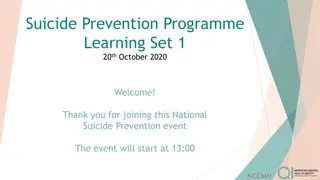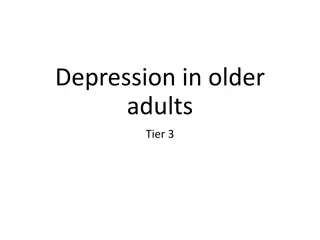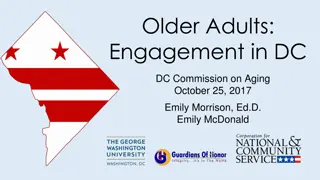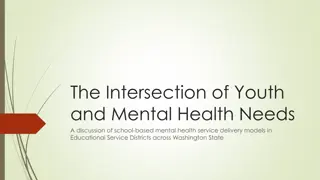Understanding Self-Harm and Suicide in Older Adults
Self-harm and suicide in older adults are serious issues that require attention due to the associated risks. The incidence of self-harm in adults aged 65 years and older is notable, with factors such as physical health conditions, pain, and psychiatric history contributing to the risk. Staff should approach reports of self-harm with compassion, taking the individual's needs and risks into account for appropriate intervention and support.
Download Presentation

Please find below an Image/Link to download the presentation.
The content on the website is provided AS IS for your information and personal use only. It may not be sold, licensed, or shared on other websites without obtaining consent from the author. Download presentation by click this link. If you encounter any issues during the download, it is possible that the publisher has removed the file from their server.
E N D
Presentation Transcript
Self harm and Suicide in older adults Tier 2
Contents Definition The potential methods that can be used The risk factors and warning signs in older adults to look out for How to respond if an older adult reports an attempt at self harm Self harm preventative strategies
Definition We are using the National Institute for Health and Care Excellence s (NICE s) definition of self harm Self-harm -is any self-injurious act carried out by a person regardless of intention e g overdose (most common, cutting or burning ). Self- harm is not used to refer to harm arising from such things as overeating/ starvation or excessive alcohol or drugs. Self harm in older adults is associated with a 100 fold increase in risks of suicide so MUST be taken seriously
Self harm in Older adults Overall incidence of self-harm in older adults aged 65 years and older was 4 1 per 10 000 person-years in study done in primary care between 2001 to 2014 Self-harm rates might be under-estimated due to stigma and shame resulting in lack of disclosure Risk of repetition is high (17%) Self harm in older adults is associated with less impulsivity and higher levels of lethal intent.
Risk factors for self harm in older adults Female People with physical health conditions Pain Alcohol and drug use Previous self-harm history Previous psychiatric history Currently having treatment for psychiatric condition (depression)
Staff approach to report of self-harm Take all self-harm seriously and listen carefully, in a calm and compassionate way Take a validating and non-judgemental approach The adult should have a psychosocial assessment of their needs as well as assessment of their current risk of repetition or suicide. Care and treatment should not be given according to a rating scale but according to a personalised assessment of risks and needs Bear in mind that if the adult is cognitively impaired you will need to ask more questions as they may have more difficulties in recalling the event Ask permission to talk to family members/friends Help the person to identify their own coping strategies and support network Offer information about support services
Staff approach to report of self-harm Inform your seniors immediately Don t think just because it was an ineffective method that it was not serious Enquire about what the adult expected to happen Hopelessness is a predictor for suicide For people who are at risk of suicide, the care plans will also need to include a Safety Plan, co-produced with the person This should have explicit reference to removal and/or mitigation of means to harm themselves, list of activities and coping strategies, and contain information on how to access social, psychological and emergency support
Other individuals who may also need support The family/friends Any staff The care team Give them information of any local support groups/help lines
Responses to avoid Staff should try to avoid the following responses towards an individual who has self- harmed Reacting with strong or negative emotions Becoming irritated Using terms such as manipulative or attention seeking Becoming frustrated Focussing too much on the self-harm itself, rather than the underlying issues
Self harm prevention strategies It is important to refrain from expressing negative views towards those engaging in self-harm. Identify older adults who self-harm Seek to understand the individual s motivations for self-harm Every older adult who self-harms should have a Safety Plan, which gives specific personalised advice to care providers on how they can reduce the individual s risk of self-harm Communities play a critical role in prevention and are key to: Providing social support to vulnerable individuals and supporting follow-up care Creating social connectedness can help protect vulnerable persons from suicide
Suicide in Older Adults Frequency Method Risk Factors Warning signs Responding to expresses suicidal ideas Managing risk Other individuals who need support Preventative strategies
Methods used for suicides in older adults Overdoses Cutting with knife / razor Drowning Hanging Any older adult who says they want to kill themselves must be taken seriously
Risk factors for suicide Self-harm is the leading risk factor for suicide Male gender Single Living alone/isolation Past psychiatric history esp. depression, anxiety, psychotic illness Depression Chronic pain Alcohol/drug use Bereavement Stressful life events Low socioeconomic status
Possible Warning signs Talking about suicidal feelings and suicide, sometimes older adult may even describe how they intend to carry out the attempt Talking about feeling worthless, hopeless, or a failure or seeing no point in life Becoming very withdrawn and uncommunicative Reports of poor sleep, loss of appetite, loss of weight
How to respond-assessing suicide risk If someone is distressed always assess their suicide risk Don t worry that asking will offend them or put ideas in their head Take a step-wise approach: Ideas: Have you ever felt so bad that you don t want to carry on? Intent: Have you ever thought about trying to harm yourself and hasten the end? Plan and means: Have you thought about what you might do this? Reasons for living / protective factors: What has stopped you from acting on those thoughts? Bear in mind that if the adult is cognitively impaired you will need to ask more questions as they may have more difficulties in recalling their thoughts
How to respond If someone reports suicidal thoughts Avoid saying, Things can't be that bad , or brushing them aside. Don't argue with the older adult but reassure them that you care about them. Be patient and listen It is difficult to support someone who is expressing suicidal ideas on your own, so seek help from a senior
Managing risk Document and share concerns: if there is a major risk, duty of care outweighs confidentiality If the person Is distressed but no intent/plan: Ask GP or Has significant thoughts about self-harm but no immediate risk: Ask GP or OOH GP or Take to A&E or Has few /no reasons for living, and the person can t assure you they will be safe if left: Don t leave alone call 999 and take to A&E .
Other individuals who may need support The family The staff The care team Other residents if they are in group living It is essential to meet with them to allow them space to talk about the incident as soon as possible after the event Give them information of any local support groups / help lines
Self harm and suicide prevention strategies Identify older adults who self-harm due to the increased risk of repetition and suicide Seek to gain an understanding of the individual s motivations for self-harm, so the appropriate support and/or referrals are put in place. Communities can provide social support to vulnerable individuals and support follow-up care Creating social connectedness can help protect vulnerable persons from suicide Fight stigma and support those bereaved by suicide Every older adult who self-harms and/or has suicidal thoughts should have a Safety Plan.
Safety Plan Required for everyone who self-harms and/or has suicidal thoughts. Co-produced with the patient Gives personalised advice to care providers on how they can reduce the individual s risk of self-harm and suicide. It should have explicit reference to: Removal and/or mitigation of means to harm themselves List of calming/distracting activities and coping strategies Information on how to access social, psychological and emergency support. Safety plan template: https://www.getselfhelp.co.uk/docs/SafetyPlan.pdf
Resources Self-harm_and_suicide_prevention_competence_framework_- _adults_and_older_adults_8th_oct_18.pdf (ucl.ac.uk) Role of primary care in supporting older adults who self-harm: a qualitative study in England | British Journal of General Practice (bjgp.org) Self-harm in a primary care cohort of older people: incidence, clinical management, and risk of suicide and other causes of death https://www.thelancet.com/journals/lanpsy/article/PIIS2215- 0366(18)30348-1/fulltext
Resources MPC_05_07 Suicide Risk And Prevention For Older People | Suicide Risk And Prevention For Older People (mindedforfamilies.org.uk) This is an easy to access website for older adults and their families which has good advice about warning signs, responding in a crisis along with practical step for family and friends























